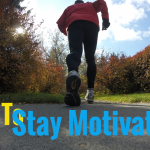The physical part of how to start to run is surprisingly easy.
The real trick, the real nut to crack, usually turns out to be the nut between our ears.
Our mind has been described, by those with more than a passing familiarity with meditation, as a house-bound monkey bouncing from window to window. Thought to thought. Minute to minute. Never resting.
But there are a few good ways to happily nudge the monkey mind into helping you start – and stay – running.
And they all involve only small, tiny even, measures of the “c” word.
Commitments, Especially Tiny Ones, Work.
Only problem is, who wants to make a commitment?
It’s too hard. You need discipline. I’m not that kind of person.
Fact is it’s not, you don’t, and you are.
Here’s why.
Commitments work because of consistency.
And consistency happens to be a highly valued social trait.
People who are consistent are deemed to be trustworthy, reliable, honest, logical and rational. Over millennia, these traits have become highly valued because they have helped us get along, build societies, develop technologies and generally make our species into what it is.
In our social hardwiring, consistency = good.
Inconsistency on the other hand signals indecisiveness, confusion, deceit or worse.
Inconsistency then = not so good.
Commitments take advantage of that near-obsessive desire – across all cultures – to be, and appear to be, consistent.
Robert Cialdini, in his book Influence, puts a marketers perspective on it:
“If I can get you to make a commitment (that is, take a stand, to go on record) I will have set the stage for your automatic and ill-considered consistency with that earlier commitment. Once a stand is taken, there is a natural tendency to behave in ways that are stubbornly consistent with that stand.”
So once you commit, once you take a stand, your mind gets busy to keep you consistent. It will devise all manner of mental gymnastics, requiring very little conscious effort on your part, to help you honor that commitment.
That’s why commitment is such a great, low energy way to accomplish things.
It’s automatic.
So it’s helpful to make a commitment or two, especially if you’re starting something new.
Like running.
But Your Mind Needs to Believe That You Can Do It.
Following a time-tested program that’s not too rigorous and that you believe you can complete helps your odds of success enormously.
If you don’t have a personal program mapped out for you, follow Jeff Galloway’s starter program.
It’s excellent for your mental game because it’s achievable, it’s not time consuming and because you’ll be healthy and in good running fitness by the end of it.
My running pal Simon recently came up lame. He has a strained calf muscle that just isn’t healing up.
One day last year, well before the troubles, I suggested to Simon before a run that we run/walk. He smirked. And, because we’ve been running together for 25 years or so, he agreed to do it just this once.
So for 11 km we ran for three minutes, then walked for 30 seconds, then ran for three minutes and so on. After 25 years of running beginning to end on every run it seemed, even to me, like it was too easy.
When we got to the end – and not, in fact, in much longer time than it would have ordinarily taken us – and we were stretching, I asked him how he felt.
He shrugged his shoulders and said in a gentle but mildly annoyed tone, “Like nothing. Like we didn’t do anything.”
And I smiled and said “I know!!! Right???”
He shrugged again.
I said “That’s the whole idea!”
Old habits, old attitudes, die hard.
About ten years ago I ran Sundays with a group who ran/walked. The walking, one minute in every 10, drove me nuts. So I can totally sympathize with Simon.
But as my Dad used to say “Too soon old, too late schmart”.
I don’t know if run/walking would have saved Simon’s calf, but I guarantee we’re both going to be run/walking when it’s healed.
Older and schmarter, we’re both coming to appreciate the enormous benefits of going easier and following a program.
And the only real difference has been inside the head.
Tough nut to crack.
Get A Little Gear.
If you don’t own anything remotely running related, treat yourself to some moderately expensive running gear.
Whether it’s a new pair of shoes, or a running jacket, or tights the idea is to get a little skin in the game.
This does a couple of insidious things.
First, it gets your mind identifying you with a new tribe – the running tribe. And it will get you doing things consistent with that tribe: like running.
And secondly, it will start getting you highly identified with the sub-tribe who bought the same stuff you did. You’ll notice ads for it. You’ll see other people wearing or using it. You may even try to emulate the celebrity athletes paid millions to endorse it (certainly the marketers’ dream). In short, you’ll be two psychological layers deep in running after a single purchase.
And you thought “In for a penny, in for a pound” had something to do with weight loss? A British pound is worth about two bucks. Once we’ve shelled out a few pennies (okay, several bucks) for something, for better or worse, we’re in for a pound.
And hey, if it takes a little cash outlay in the service of a higher purpose, I’m all for it.
Go Public.
Want to really boost your mental game?
Tell someone else what you’re planning to do – your spouse, your best friend, your Facebook followers – make it public and report your progress.
Nothing will sharpen your motivation like publicly taking that stand and using social consistency as your biggest ally.
Monkey mind will shape up and fly straight in no time at all.
Plug In
The more you’re plugged in to running, the easier it is to conquer the resistance and the more you’re committed.
And there are a lot of easy ways to plug in.
Subscribe.
The most non-intrusive way to prime your mind for running is to subscribe to a running magazine. And the granddaddy of running mags is Runner’s World. Since 1966, it’s been the premier periodical for everything happening in the world of running. With 18 international editions published, it covers a lot of ground with articles on everything from – in a recent issue – running with dogs to Chi running. But there are other good magazines (e.g., Women’s Running, Club Running) with a much narrower focus that might suit you as well.
Getting a monthly dose of running advice delivered to your door is a great way of keeping your mind in the groove.
Run with Friends.
If you’re lucky enough to have a friend who is already a runner – and about the same speed as you – or who wants to get started too, this is good.
Joining a local running club can be a tremendous idea – especially if you’re serious about running and you don’t mind running with, some very quick people. Running clubs come in all shapes and sizes too, so if you can find one that fits your needs, go for it.
Most running stores host regular runs from the store and many also coordinate races and run training programs. Running-store-centred programs are de-facto running clubs and are a terrific place to start – especially if you’re new to town, new to running, or you just want to expand your circle of friends while following a running program and getting fit.
Volunteer at a Race.
I know tons of runners who would almost sooner do this than race. If you’re not ready to race, or you’re injured or you’re just flat-out civic-minded, volunteer. You’ll meet plenty of friendly people, you’ll get a feel for the running culture and you’ll see first-hand what racing is like – without having to break a sweat.
Most races need marshals who make sure that the racers stay on course, that cars and racers don’t intersect, and that racers get a little encouragement out there. If you like to encourage people or direct traffic, get out on the course and marshal.
Races also need volunteers to do things like hand out race bling, put together race packages, time races, run the start and finish lines, set up signage, run the runner’s fair – among a ton of other interesting assignments. You’ll bump into people there who are completely into running and their enthusiasm is infectious.
One way or the other, volunteering at a race is a great way to plug into the people, the energy, and the excitement of running. And you’ll probably realize that most runners are pretty much just like you.
Plus, there’s nothing like the smell of Rub A535 and Tiger Balm at the start line in the morning.
Ultimately, there are a ton of ways to get that mental monkey on your side, to crack that nut, so you can safely, consistently and happily get with a new program and start to run.
It all boils down to making some very small commitments.
That’s it.
If you’ve got some other ways that help you get the mental job done (so the physical is a breeze), I’d love to hear from you in the Comments section below.
See you out there!












Excellent tip here, I so agree with the commitment. Without a real tangible goal its so easy to start “tomorrow” Throw your hat into the ring properly and you are forced to start TODAY!
It can be so hard to actually get your butt out the door you need something to help force it! For me that’s being signed up to a race. I know how awful it is to race underprepared so knowing a race is looming always gets me out the door!
I agree 100% Steve. Being signed up for a race is highly motivational. And there’s nothing like (meaning nothing much fun about) running out of gas halfway into a race and having to hobble, or get a ride, back. But with some smart preparation, e.g., a program you can start today, it’s a lot easier to get out the door to train – and eventually across the finish line.
Looks like training’s not a problem for you!
Have fun Steve, and I’ll see you out there.
Larry
I usually walk a lot and did some of the running to in the past. I love to walk and run it is so much reliving and gets all the stress part out of me too. But after I had the calcium stone issue I was forbidden to run it took away my habit. I do trekking and it helps me a lot, still I would like to know if I start up running and I still have not flushed all of the stones out of my system, will it be considerable?
Hi Sujit – and thanks for the comment. Good to hear you’re out walking. Always good!
The quick research I did would indicate that people do still run with stones. They make sure they’re well hydrated and taking pain-killers in the event of an attack. But if your were forbidden (by your doctor I’m assuming) to run it’s probably a good idea to follow her (his) instructions.
All the best for a quick recovery and relief from those stones! See you out there.
I used to run many years ago and now for the life of me I don’t know why I stopped. This may sound strange but I found it peaceful and relaxing while running. I found it to be a great stress reliever also.
If I were to try running again I would definitely do it the run/walk way.
Right now I do take my dog out for a walk everyday and I bet she wouldn’t mind picking up the pace a bit.
Thanks for the info!
I take my dog out for a walk every day too Maureen – and I haven’t stumbled on anything that’ll pick up the pace much either!
The walk though fits right into Jeff’s starter run/walk program. And with a 5 second on, 55 second off run (pretty much just walking) I’m thinking that little 5-second jog every minute with my dog won’t hurt him much. Not too much anyway. He probably won’t even notice!
Thanks for the post! See you out there!